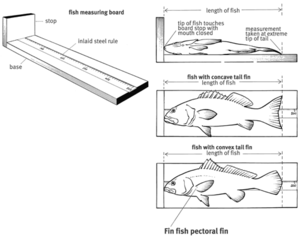Does your catch measure up?
Wednesday November 6th 2013
Does your catch measure up?
While fishers love to tell tales about the size of the ones that got away, it is important they make sure the ones they keep are measured accurately to ensure they comply with Queensland size limits.
Queensland Boating and Fisheries Patrol district officer Graeme Broughall said recently there had been an increase in the number of fishers measuring their catch incorrectly.
“The correct way to measure a fin fish is lying on their side and measuring from the tip of their snout to the end of their tail,” Mr Broughall said.
“The fish should not be manipulated in any way when measuring. For example, fishers shouldn’t pinch the tail together to lengthen a fish’s overall length.
“A sturdy ruler or coil tape measure with an end stop on it is the most accurate tool for measuring fish. By having an end stop, it means the fish can be put against the edge for accuracy.
“Measuring devices which are adhesive or flexible should only be used as a guide. Stick-on rulers and similar devices sometimes shrink when exposed to the weather so are unreliable and could give an incorrect measurement.
“If a fisher catches an undersize or unwanted fish they should return it to the water immediately taking as much care as possible to avoid causing the fish any injury.”
Mr Broughall said mud crabs were measured from point-to-point across the widest part of the shell and must be a minimum size of 15cm.
Blue swimmer crabs are measured from the notch immediately forward of the base of the largest lateral spine and this notch-to-notch measurement must be a minimum of 11.5cm.
“The easiest and most accurate way to measure a crab is with a crab gauge which can be found at bait and tackle shops,” Mr Broughall said.
“Recreational fishers should also remember that female mud and blue swimmer crabs are protected in Queensland.”
For more information on size and possession limits in Queensland, visit www.fisheries.qld.gov.au or call 13 25 23.

